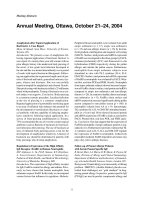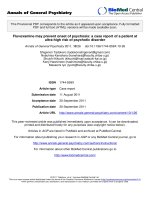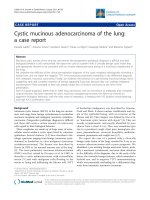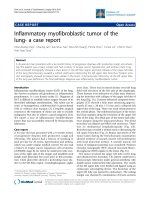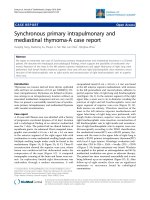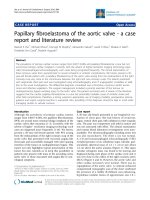Báo cáo y học: " Digital gangrene associated with anticentromere antibodies: a case report." pdf
Bạn đang xem bản rút gọn của tài liệu. Xem và tải ngay bản đầy đủ của tài liệu tại đây (793.21 KB, 4 trang )
JOURNAL OF MEDICAL
CASE REPORTS
Bolster et al. Journal of Medical Case Reports 2010, 4:189
/>Open Access
CASE REPORT
© 2010 Bolster et al; licensee BioMed Central Ltd. This is an Open Access article distributed under the terms of the Creative Commons
Attribution License ( which permits unrestricted use, distribution, and reproduction in
any medium, provided the original work is properly cited.
Case report
Digital gangrene associated with anticentromere
antibodies: a case report
Lauren Bolster
1
, Regina M Taylor-Gjevre*
2
, Bindu Nair
2
and John A Gjevre
3
Abstract
Introduction: Anticentromere antibodies have been associated with peripheral vascular occlusive disease, most
frequently accompanied by sclerodactyly in the context of a connective tissue disorder. We report a case of digital
gangrene with no other clinical associations except positive anticentromere antibodies.
Case presentation: Our patient, a 53-year-old Caucasian woman, non-smoker, presented with progressive pain and
blackening of the distal right third finger over the preceding five weeks. No sclerodactyly was evident. She was
anticentromere antibody positive at greater than 100 U/mL. Angiography revealed diffuse distal vasculopathy in both
upper extremities. Other investigations were unremarkable.
Conclusions: It is rare for anticentromere antibody-associated digital necrosis to develop without concomitant
sclerodactyly. However, this patient's case illustrates the need to consider an autoimmune contribution to the
pathogenesis of digital ischemia even in the absence of a recognizable connective tissue disease.
Introduction
The presence of anticentromere antibodies (ACA) is
most commonly associated with limited scleroderma. To
a lesser extent, ACA have been reported in other disor-
ders including: Raynaud's syndrome, Raynaud's phenom-
enon associated with sclerodactyly, primary biliary
cirrhosis (PBC), and Sjogren's syndrome [1-5]. Patients
with circulating ACA associated with limited sclero-
derma or sclerodactyly have been reported to be at
increased risk of significant peripheral vascular occlusive
disease [6,7]. We report the case of a 53-year-old woman
presenting with digital gangrene and a positive ACA
without other features of connective tissue disease.
Case presentation
A 53-year-old Canadian Caucasian woman, who was a
clerical worker, presented to her family doctor with a five
week history of progressive pain and black discoloration
of the distal right third finger. She was initiated on acetyl-
salicylic acid and warfarin and referred to a regional ter-
tiary care hospital.
Her past medical history included depression and a
diagnosis of Wolfe Parkinson White (WPW) syndrome,
treated since childhood with verapamil. She was taking
no other medications. She has never smoked and denied
a history of Raynaud's type changes in her digits. Her
connective tissue disease review of systems was also oth-
erwise unremarkable.
On examination in the emergency room, there was
obvious digital necrosis of the distal right third finger
with an adjacent area of pale swollen tissue with ulcer-
ation (Figure 1). Allen's test was abnormal with poor refill
bilaterally. Capillaroscopic examination of the periungal
regions did not reveal dilated capillary loops. No periph-
eral bruits were audible. A teleangiectasia lesion was evi-
dent on the fifth digit. No other skin changes, specifically
sclerodactyly, were present. She was admitted to hospital
for further investigations and consultation with vascular
specialists.
An angiogram revealed evidence of a bilateral oblitera-
tive vasculopathic process (Figures 2 and 3). Radiographs
of the hands did not reveal any bony abnormality. Further
investigations revealed a positive antinuclear antibody
with titer > 1280 and anticentromere specificity. ACA
were confirmed by enzyme-linked immunosorbent assay
(ELISA) at greater than 100 U/mL. Anti-double stranded
DNA, anti-Sjogrens Syndrome A, anti-Sjogrens Syn-
* Correspondence:
2
Division of Rheumatology, Department of Internal Medicine, University of
Saskatchewan, Saskatoon, SK, Canada
Full list of author information is available at the end of the article
Bolster et al. Journal of Medical Case Reports 2010, 4:189
/>Page 2 of 4
drome B and anti-ribonucleoprotein antibodies (anti-
SSA, anti-SSB, anti-RNP), anti-Sm, anti-Scl-70, antineu-
trophil cytoplasmic antibodies, anticardiolipin antibod-
ies, cryoglobulins, C3, C4, C-reactive protein, complete
blood count, electrolytes, creatinine, hepatic transami-
nases, alkaline phosphatase and urinalysis were all nor-
mal or negative. Associated underlying pathology
including cardiopulmonary, gastrointestinal and renal
involvement were excluded through cardiology consulta-
tion, chest radiograph, echocardiogram, pulmonary func-
tion testing, high-resolution computerized tomography
(CT) of the chest, 24 hour urine for creatinine clearance,
serum chemistry and urinalysis, barium swallow, and CT
abdomen and pelvis.
In hospital she was initiated on clopidogrel bisulfate,
pentoxifylline, topical nitropaste, a two week trial of
prednisone, a seven day course of clindamycin and mor-
phine for pain control. Nifedipine was later initiated as an
out-patient. Gradually over the next two months the
necrosis resolved with minimal tissue loss at the digit tip.
She continues to be followed in the rheumatology out-
patient clinic with periodic evaluations for potential evo-
lution of connective tissue disease and in cardiology
clinic for follow-up of her WPW.
Discussion
The association of ACA with peripheral vasculopathy
and digital necrosis has been well recognized in the sys-
temic sclerosis population [8]. This association has also
been reported in patients whose disease is on the edge of
the systemic sclerosis spectrum with Raynaud's and scle-
rodactyly alone [1,6]. However, it is most unusual for
ACA positive patients without concomitant sclerodactyly
to develop digital necrosis [8,9].
In our review of the published literature (Table 1), we
observed the majority of reported patients had pre-exist-
ing Raynaud's phenomenon recognized well prior to the
advent of digital necrosis. Other vascular risk factors
including smoking, malignancy or previous thermal
injury had also been identified in many of these cases.
Our patient is the only case we are aware of in which the
digital necrosis presented in isolation.
It has been postulated that ACA, rather than being a
marker antibody may have a direct pathogenic role in
vascular endothelial injury [10,11]. It has been observed
that human dermal endothelial cells (HDEC) exposed to
sera containing ACA demonstrate increased apoptosis
and altered gene expression. These include increased
expression of genes linked to apoptosis and development
of fibrosis, as well as diminished expression of angiogene-
sis promoting genes [12]. Sera containing ACA has also
been shown to have activity against human umbilical vein
endothelial cells [13].
Another point of interest in this patient's history is the
coexistence of WPW. In this case, the WPW diagnosis
dates back to childhood, and is unlikely to be related to
the current presentation. However, development of
WPW has been recently reported in a patient with sclero-
derma siné scleroderma [14]. Gross abnormalities in the
conducting system have been demonstrated in systemic
sclerosis patients via electrophysiologic testing [15]. It has
been hypothesized, that myocardial fibrosis may provide
substrate necessary for reentrant tachycardia [16-18].
Potentially anti-endothelial activity in ACA positive sera
could influence the development of myocardial fibrosis.
In summary, we present a case of a 53-year-old woman
with possible early scleroderma [19] who presents with a
Figure 1 A photograph of the symptomatic hand demonstrating
digital gangrene. The fingernails are discolored from the presence of
residual 'gel-nails'.
Figure 2 Angiographic image from the right distal upper extrem-
ity demonstrating poor distal flow.
Figure 3 Angiographic image from the left distal upper extremity
demonstrating poor distal flow.
Bolster et al. Journal of Medical Case Reports 2010, 4:189
/>Page 3 of 4
gangrenous digit, occlusive vasculopathy and a positive
ACA, without sclerodactyly, a previous history of Ray-
naud's phenomenon, or other stigmata of connective tis-
sue disease.
Conclusions
Our patient's case illustrates the need to consider an
autoimmune contribution to pathogenesis of digital isch-
emia even in the absence of a recognizable connective tis-
sue disease. Furthermore, digital ischemia may be the
presenting feature or initial manifestation of an underly-
ing evolving connective tissue disease.
Consent
Written informed consent was obtained from the patient
for publication of this case report and any accompanying
images. A copy of the written consent is available for
review by the Editor-in-Chief of this journal.
Competing interests
The authors declare that they have no competing interests.
Authors' contributions
LB, RTG, BN and JG all analyzed and interpreted aspects of the clinical data
associated with this patient's presentation and implications of the same. LB
and RTG reviewed the literature and wrote the manuscript. All authors partici-
pated in revising and approving the final manuscript.
Author Details
1
Department of Internal Medicine, University of Saskatchewan, Saskatoon, SK,
Canada,
2
Division of Rheumatology, Department of Internal Medicine,
University of Saskatchewan, Saskatoon, SK, Canada and
3
Division of
Respirology, Department of Internal Medicine, University of Saskatchewan,
Saskatoon, SK, Canada
References
1. Miyawaki S, Asanuma H, Nishiyama S, Yoshinaga Y: Clinical and
serological heterogeneity in patients with anticentromere antibodies.
J Rheumatol 2005, 32:1488-1494.
2. Fritzler MJ, Kinsella TD: The CREST syndrome: a distinct serologic entity
with anticentromere antibodies. Am J Med 1980, 69(4):520-526.
3. Weiner ES, Earnshaw WC, Senecal JL, Bordwell B, Johnson P, Rothfield NF:
Clinical associations of anticentromere antibodies and antibodies to
topoisomerase I. A study of 355 patients. Arthritis and Rheum 1988,
31(3):378-385.
Received: 28 October 2009 Accepted: 22 June 2010
Published: 22 June 2010
This article is available from: 2010 Bolster et al; licensee BioMed Central Ltd. This is an Open Access article distributed under the terms of the Creative Commons Attribution License ( which permits unrestricted use, distribution, and reproduction in any medium, provided the original work is properly cited.Journal of Medical Case Repo rts 2010, 4:189
Table 1: ACA associated digital necrosis without sclerodactyly: a case comparison
Report Age (years) Sex Pre-existing
Raynaud's
Raynaud's
duration
Region affected Co-morbidities Smoker
Leon-Perez[20] 3 cases
(39-62)
M Yes (× 3) NR NR Past frostbite (× 2),
HTN (× 2)
Yes (× 3)
Barr[21] 67 M Possible NR Fingers CAD, CAGB No
Takahashi[10] 60 F Yes 3 months Fingers, toes NR NR
74 F Yes 54 years Fingers NR NR
79 F Yes 30 years Toes CVA NR
Picillo[22] 34 F Yes 12 years Fingers, toe None Yes
Sachsenberg-Studer[11] 43 F Yes 2 years Fingers None Yes
73 F Yes 12 years Fingers HTN Never
84 F Yes Unknown Fingers, toes HTN Never
86 F Yes Unknown Fingers, toe None Never
Brown[23] 87 F No Fingers CHF, HTN Never
El Mahou[24] 72 M Yes NR Fingers, toes SCC Ex-smoker
Current case 53 F No Finger WPW Never
CABG, coronary artery bypass graft; CAD, coronary artery disease; CVA, cerebrovascular accident; HTN, hypertension; NR, not reported; SCC: small
cell lung cancer.
Bolster et al. Journal of Medical Case Reports 2010, 4:189
/>Page 4 of 4
4. Vlachoyianopoulos PG, Drosos AA, Wiik A, Moutsopoulos HM: Patients
with anticentromere antibodies, clinical features, diagnoses and
evolution. Br J Rheumatol 1993, 32(4):297-301.
5. Chou MJ, Lee SL, Chen TY, Tsay GJ: Specificity of antinuclear antibodies
in primary biliary cirrhosis. Ann Rheum Dis 1995, 54(2):148-151.
6. Wigley FM, Wise RA, Miller R, Needleman BW, Spence RJ: Anticentromere
antibody as a predictor of digital ischemic loss in patients with
systemic sclerosis. Arthritis and Rheum 1992, 35(6):688-693.
7. Herrick AL, Heaney M, Hollis S, Jayson MI: Anticardiolipin, anticentromere
and anti-Scl-70 antibodies in patients with systemic sclerosis and
severe digital ischaemia. Ann Rheum Dis 1994, 53:540-542.
8. Chung L, Fiorentino D: Digital ulcers in patients with systemic sclerosis.
Autoimmun Rev 2006, 5(2):125-128.
9. Guiducci S, Giacomelli R, Cerinic MM: Vascular complications of
scleroderma. Autoimmun Rev 2007, 6(8):520-523.
10. Takahashi M, Okada J, Kondo H: Six cases positive for anti-centromere
antibodies with ulcer and gangrene in the extremities. Br J Rheum
1997, 36:889-893.
11. Sachsenberg-Studer EM, Prins C, Saurat JH, Salomon D: Raynaud's
phenomenon, anticentromere antibodies, and digital necrosis without
sclerodactyly: an entity independent of scleroderma? J Am Acad
Dermatol 2000, 43:631-634.
12. Ahmed SS, Tan FK, Arnett FC, Jin L, Geng YJ: Induction of apoptosis and
fibrillin 1 expression in human dermal endothelial cells by scleroderma
sera containing anti-endothelial cell antibodies. Arthritis Rheum 2006,
54(7):2250-2262.
13. Hill MB, Phipps JL, Cartwright RJ, Milford Ward A, Greaves M, Hughes P:
Antibodies to membranes of endothelial cells and fibroblasts in
scleroderma. Clin Exp Immunol 1996, 106(3):491-497.
14. Park YW, Woo H, Yoon HJ, Park HW, Cho JG, Shin SS, et al.: Systemic
sclerosis sine scleroderma associated with Wolff-Parkinson-White
syndrome. Scand J Rheumatol 2007, 36(1):68-70.
15. Rokas S, Mavrikakis M, Agrios N, Mylonas D, Antoniadou L, Moulopoulos S:
Electrophysiologic abnormalities of cardiac function in progressive
systemic sclerosis. J Electrocardiol 1996, 29(1):17-25.
16. Deswal A, Follansbee WP: Cardiac involvement in scleroderma. J
Electrocardiol 1996, 29(1):17-25.
17. Lazzerini PE, Capecchi PL, Guideri F, Acampa M, Galeazzi M, Laghi Pasini F:
Connective tissue diseases and cardiac rhythm disorders: an overview.
Autoimmun Rev 2006, 5(5):306-313.
18. Seferovic PM, Ristic AD, Maksimovic R, Simeunovic DS, Ristic GG,
Radovanovic G, et al.: Cardiac arrhythmias and conduction disturbances
in autoimmune rheumatic diseases. Rheumatology 2006, 45(S4):39-42.
19. LeRoy EC, Medsger TA Jr: Criteria for the classification of early systemic
sclerosis. J Rheum 2001, 28(7):1573-1576.
20. Leon-Perez R TN: Digital vasculitis associated with centromere
antibodies. Arthritis Rheum 1986, 29:S89.
21. Barr WG, Robinson JA: Systemic sclerosis and digital gangrene without
scleroderma. J Rheum 1988, 15(5):875-877.
22. Picillo U, Marcialis MR, Matarazzo A, Italiano G, Petti A: Digital gangrene
and anticentromere antibodies without scleroderma. Br J Rheum 1998,
37(12):1352-1323.
23. Brown N, Rhys-Dillon CC, Martin JC: Isolated digital infarction associated
with anticentromere antibody. Rheumatology 2001, 40:355-357.
24. El Mahou S, Sailler L, Madaule S, Arlet P: RACAND syndrome as a
paraneoplastic syndrome? J Clin Rheum 2006, 12(2):104-105.
doi: 10.1186/1752-1947-4-189
Cite this article as: Bolster et al., Digital gangrene associated with anticen-
tromere antibodies: a case report Journal of Medical Case Reports 2010, 4:189
